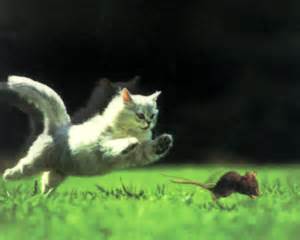If an exercise wheel sits in a forest, will mice run on it?
如果把跑轮放在森林里,小鼠会上去跑步吗?
Every once in a while, science asks a simple question and gets a straightforward answer.
科学时常会提出一个简单的问题,然后得到一个直截了当的答案。
In this case, yes, they will. And not only mice, but also rats, shrews, frogs and slugs.
这个问题的答案是,会。不仅小鼠会,大鼠、鼩鼱、青蛙和蛞蝓都会。
True, the frogs did not exactly run, and the slugs probably ended up on the wheel by accident, but the mice clearly enjoyed it. That, scientists said, means that wheel-running is not a neurotic behavior found only in caged mice.
当然,青蛙算不上在跑,蛞蝓可能也是偶然来到跑轮上的,但是小鼠明显是真的喜欢跑轮。科学家表示,这说明在跑轮上跑步并不是关在笼子里的老鼠才有的神经性举动。
They like the wheel.

Two researchers in the Netherlands did an experiment that it seems nobody had tried before. They placed exercise wheels outdoors in a yard garden and in an area of dunes, and monitored the wheels with motion detectors and automatic cameras.
荷兰的两名研究员做了一项似乎从来没人做过的实验。他们在室外的院子和一块沙地里放置了一些跑轮,并通过运动检测器和自动相机对这些跑轮进行监测。
They were inspired by questions from animal welfare committees at universities about whether mice were really enjoying wheel-running, an activity used in all sorts of studies, or were instead like bears pacing in a cage, stressed and neurotic. Would they run on a wheel if they were free?
他们的灵感来自一些大学的动物福利委员会所提出的问题。这些委员会质疑小鼠是否真的喜欢在轮子上跑步——所有研究都会用到这个活动,或者还是像在笼子里踱步的熊那样,出于压力和紧张。如果处于自由状态,它们还会在轮子上跑步吗?
Now there is no doubt. Mice came to the wheels like human beings to a health club holding a spring membership sale. They made the wheels spin. They hopped on, hopped off and hopped back on.
目前,这一点毫无疑问。到跑轮上跑步的小鼠,就像来到正在举行春季促销的健身俱乐部的人类一样。他们开始让轮子转动。它们跳上去、跳下来,然后再跳上去。
"When I saw the first mice, I was extremely happy," said Johanna H. Meijer at Leiden University Medical Center in the Netherlands. "I had to laugh about the results, but at the same time, I take it very seriously. It's funny, and it's important at the same time."
“当我看见第一只小鼠时,我非常高兴,”荷兰莱顿大学医学中心(Leiden University Medical Center)的约翰娜·H·梅杰(Johanna H. Meijer)说。“这些结果不能不让我觉得可笑,但同时,我也会认真对待它。这很有趣,同时也很重要。”
Dr. Meijer's day job is as a "brain electrophysiologist" studying biological rhythms in mice. She relished the chance to get out of the laboratory and study wild animals, and in a way that no one else had.
梅杰的正职工作是研究小鼠生物节律的“脑电生理学家”。她非常享受走出实验室,以前所未有的方式研究野生动物的机会。
She said Konrad Lorenz, the great-grandfather of animal behavior studies, once mentioned in a letter that some of his caged rats had escaped and then returned to his garden to use running wheels placed there.
她说,动物行为研究的鼻祖康拉德·洛伦茨(Konrad Lorenz)曾在一封信中提到,有些被他关在笼子里的大鼠逃走后,又回到他的花园,到放在那里的跑轮上跑步。
But, Dr. Meijer said, the Lorenz observation "was one sentence."
但是,梅杰说,洛伦茨的观察“只是一句话”。
For the experiment, the wheels were enclosed so that small animals could come and go but so that larger animals could not knock them over. Dr. Meijer set up motion sensors and automatic video cameras. Several years and 12,000 snippets of video later, she and Yuri Robbers, also a Leiden researcher, reported the results. They were released online Tuesday in the Proceedings of the Royal Society B.
为了进行试验,跑轮被围了起来,这样小动物就能来去自由,大动物则无法把它们撞翻。梅杰安放了运动传感器和自动摄影机。她和同为莱顿研究人员的尤里·罗伯斯(Yuri Robbers)报告称,几年后,他们获得了1.2万个视频片段。周二,这些结果被公布在了《英国皇家学报B》(Proceedings of the Royal Society B.)的网站上。
Gene D. Block, chancellor of the University of California, Los Angeles, was not involved with the paper but knows Dr. Meijer and had seen the wheel set up in her garden. He said the study made it clear that wheel-running is "some type of rewarding behavior" and "probably not driven by stress or anxiety."
加州大学洛杉矶分校校长吉恩·D·布洛克(Gene D. Block)与这篇论文无关,但是他认识梅杰,而且还见过她在花园里放置的跑轮。他说,研究表明在跑轮上跑步是“一种有益的行为”,“可能不是出于压力或焦虑”。
Mice accounted for 88 percent of the wheel-running events, and spent one minute to 18 on the wheel. The other animals each accounted for less than 1 percent. Frogs, though there were very few, were seen to get on the wheel, get off and get back on.
在所有在跑轮上跑步的动物中,小鼠占了88%,在跑轮上花费的时间为1到18分钟。其他每种动物所占的比例不到1%。虽然数量不多,但是我们也看到青蛙爬上跑轮,爬下来,然后又爬回去。
Russell Foster, a circadian rhythm researcher at Oxford University, said he read the paper and sent it out to other scientists on behalf of the Proceedings and was delighted when peer reviews from other scientists were positive.
罗素·福斯特(Russell Foster)是牛津大学(Oxford University)的一名生理节律研究员。他说他读过这篇论文,并代表《英国皇家学报B》把它发给了其他科学家。其他科学家都对此持肯定态度,这让他感到高兴。
Marc Bekoff, a professor of ecology and evolutionary biology at the University of Colorado who is active in the animal welfare movement, said in an email that he thought the paper did show that wheel-running could be a "voluntary activity," but that mice in labs may be doing more of it because of the stress of confinement.
马克·贝科夫(Marc Bekoff)是科罗拉多大学(University of Colorado)的一名生态学和进化生物学教授,积极参与动物福利运动。他在电子邮件中说,他认为这篇论文的确表明跑轮运动可能是一种“自愿活动”,但是实验室的老鼠可能会因为禁闭的压力而进行更多跑轮运动。
"Wild bears will often pace back and forth," he wrote, "but in captivity, the rate of doing it seems to be greatly heightened."
“野熊经常会来回踱步,”他写道,“但是如果被关起来,他们踱步的频率似乎就会大幅度增加。”
As to why the mice, frogs or perhaps even slugs run, or move, on the wheel, Dr. Meijer said she thought that "there is an intrinsic motivation for animals, or should I say organisms, to be active."
至于为什么小鼠、青蛙或者甚至连蛞蝓都会在跑轮上跑步或移动,梅杰说她认为“动物天生具有行动的欲望,或者说保持活跃的机制”。
Huda Akil, co-director of the Molecular and Behavioral Neuroscience Institute at the University of Michigan, who has studied reward systems, said: "It's not a surprise. All you have to do is watch a bunch of little kids in a playground or a park. They run and run and run."
研究过奖励机制的密歇根大学(University of Michigan)分子和行为神经研究中心(Molecular and Behavioral Neuroscience Institute)主任胡达·阿基勒(Huda Akil)说:“这并不意外。你需要做的就是看一群小孩在操场或公园里玩耍。他们会一直跑,一直跑,一直跑。”
Dr. Akil said that in humans, running activates reward pathways in the brain, although she pointed out that there are innate differences in temperament in all sorts of animals, including humans. Rats that do not like to run can be bred. And plenty of people do all they can to avoid jogging, cycling and elliptical machines.
阿基勒说,在人类身上,跑步运动可以激活大脑里的奖励回路,虽然她指出所有动物的秉性都存在固有的不同,人类也是如此。可以培育出不爱跑的大鼠。而极尽可能地避免慢跑、骑车和玩椭圆机的人类也多得是。
Presumably, the same is true of wild mice. While some were setting the wheel on fire with their exertions, others, out of camera range, may have been sprawled out on the mouse equivalent of a lounge chair, shaking their whiskers in dismay and disbelief.
大概对于野鼠而言也是如此。虽然有些老鼠正在跑轮上奋力奔跑,但是那些不在摄像机覆盖范围内的老鼠,可能正慵懒地躺在老鼠版的休闲椅上,在惊恐或犹疑中抖着胡须。












